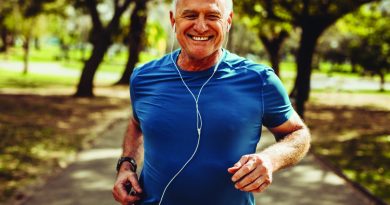Start your successful aging plan in your 30s
In your 30s and 40s it may not be a stretch to run alongside a toddler or a teen, but it’s a progressive downslide on the mobility, flexibility, strength and balance front into your 50s, 60s and 70s if your only daily movement consists of shuffling papers on a desk, or going for an occasional stroll.
If you desire to age successfully – to have enough balance and strength to prevent falls; sufficient bone density to prevent breaks; enough mobility to walk up a set of stairs comfortably; and enough flexibility to put on your own shoes, then exercise, in some way shape or form, is non-negotiable. It’s a fact of life, and no miracle pill can replace exercise. If quality of life is important to you, then functional exercise needs to be factored into your quality-of-life equation, even in your 30s.
Even if you are normal weight at present, inactive, and in your 30s, expect to lose up to eight pounds of muscle per decade, according to a 2004 review – Muscle Tissue Changes with Aging – in the journal Current Opinion in Clinical Nutrition and Metabolic Care. That’s 42 pounds of valuable muscle lost in just four decades – muscle that makes walking easier. By the time you hit your 70s, you’re shuffling along like Mr.Tudball from the 70s comedy sketches on the Carol Burnett Show, and realizing you don’t have enough balance and strength to even step on a low stool to reach into the cupboard, for fear of falling.
A 2018 research paper in the Journal of Physiology found that “healthy elderly people walk slower and energetically less efficiently than young adults” and that “this decline in walking performance lowers the quality of life for a growing ageing population.”
The good news is the decline in ability to walk efficiently is directly related to the loss of muscle strength and mass, according to the research, and as such, this is something we can do something about if quality of life is important to us as we age.
Lack of exercise not only hinders one’s ability to walk effectively, but without exercise to maintain balance and strength, one is setting the stage for a potentially life-threatening fall.
In 2014, elderly Americans ages 65 and up experienced 29 million falls, which caused seven million injuries, resulting in $31 billion in health care costs, according to a report published by the Centres for Disease Control and Prevention.
The good news is, we can make a choice to age successfully, and it’s never too early to start planning a successful-aging strategy.
Joining a gym is an option, or taking up yoga or hiring a personal trainer, but if you’re looking for an easy way out then the quickest and most body-friendly way to hold on to muscle, balance, mobility, flexibility and bone density is through rebounding. Jumping up and down on a quality mini trampoline for as little as 10 minutes a day does the trick. Quality is the operative word here if rebounding is being considered, otherwise your joints will not be happy campers.
Rebounding on a quality rebounder trumps all other forms of exercise as it can be done daily and with little to no strain on joints. Quality rebounders are like a non-exercisers dream. True rebounders are made to absorb the impact of each bounce, creating the right resistance, without risking injury. If physical movement is a challenge, know that your feet don’t even need to leave the rebounder mat to benefit. A stabilizing bar is also available for you to hold onto while exercising.
Rebounding allows you to feed two birds with one worm: build and maintain physical fitness levels, while elevating your wellbeing. Only two minutes of jumping on a rebounder flushes the entire lymphatic system, tripling white blood cell count, and boosting your immunity, research from MedFit Network shows. Who doesn’t have two minutes a day to boost their wellbeing?





